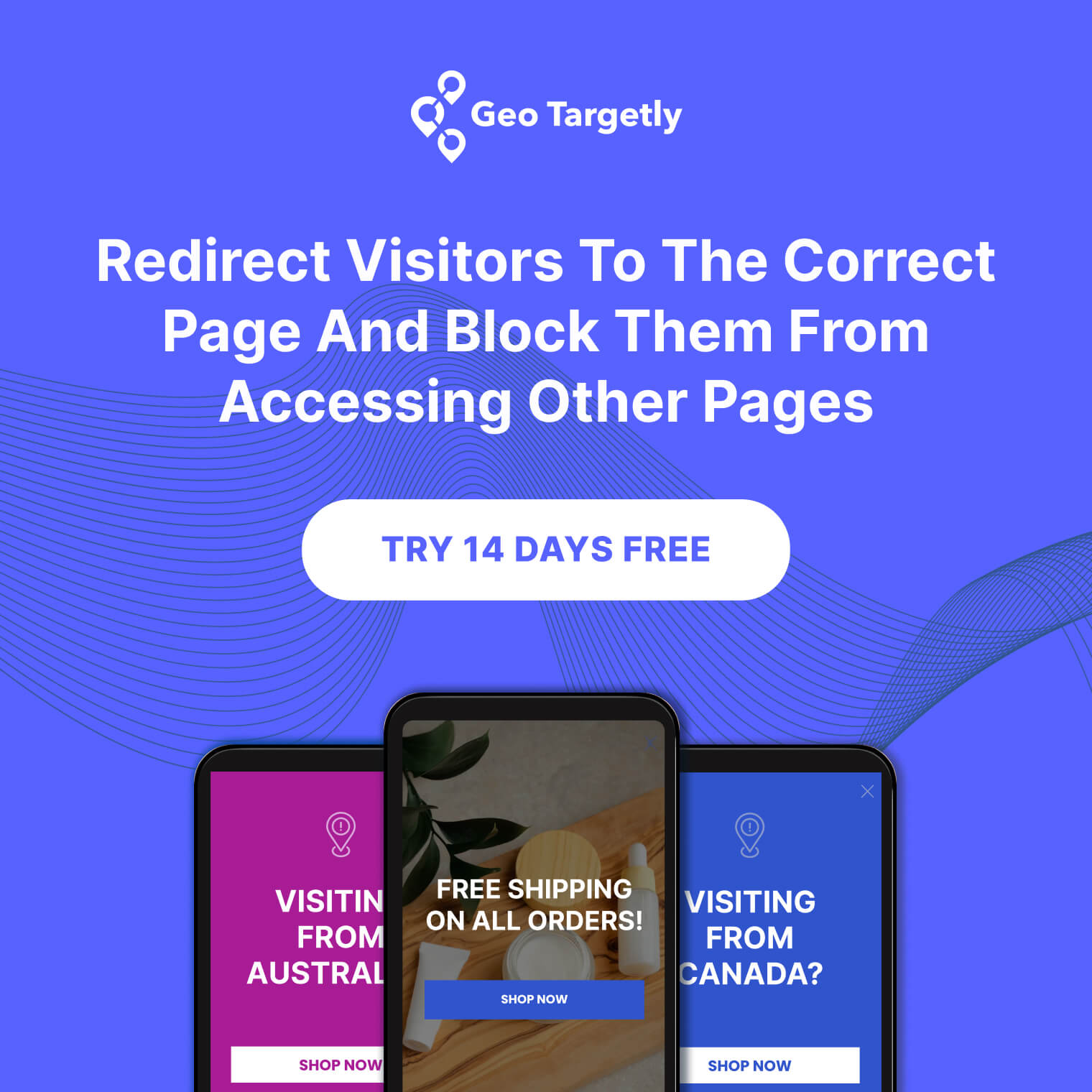

A cookie notice is a message displayed on websites to inform users that cookies are being used to collect data about their browsing activities.
These notices play a critical role in ensuring compliance with global data protection laws such as the GDPR (General Data Protection Regulation) and CCPA/CPRA (California Consumer Privacy Act/California Privacy Rights Act).
In addition to compliance, cookie notices help build transparency and trust with users by informing them how their data is collected and used.
In this guide, we’ll break down what cookie notices are, why they’re essential, the key legal requirements, and practical tips for implementing them effectively.
TIP: Automatically redirect your visitors to the appropriate cookie notice based on their location with our new Geo Consent feature—no technical skills required.
What is a Cookie Notice?
A cookie notice is a banner or pop-up that appears when a user visits a website, informing them about the use of cookies and requesting consent for data collection. Cookies are small files stored on a user’s device to track their activity, remember preferences, and improve website functionality.
It’s important to differentiate between:
- Cookie Notice: The banner or message informing users about cookie usage.
- Cookie Policy: A detailed document explaining what cookies are used, their purposes, and how users can manage them.
- Cookie Banner: The visual component of the cookie notice that prompts user interaction.
An effective cookie notice makes users aware of the cookies being used and provides them with choices on how to manage their preferences.
Why are cookie notices necessary?
Cookie notices are legally required in many jurisdictions to promote transparency about how websites collect and use data. Here are the main reasons they’re necessary:
Legal compliance
The GDPR in the European Union and the CCPA/CPRA in California require websites to inform users about data collection and provide options to manage their consent. Non-compliance can result in significant fines.
And while ensuring cookie compliance is important for protecting user privacy online, it’s also just one part of a broader legal foundation every business needs. Setting up your business structure properly, such as forming an LLC or corporation, can help safeguard your operations and limit personal liability from the start. For example, if you're starting a business in California, forming a California LLC can provide personal liability protection and it’s important for online businesses that rely on user trust and compliance with regulations like the CCPA.
Building user trust
Transparency builds trust. Users are more likely to engage with websites that are open about how their data is collected and used. Cookie notices show users that their privacy is taken seriously.

GDPR cookie notice requirements
The GDPR sets strict guidelines for cookie notices to give users control over their data. Key requirements include:
- Explicit consent must be obtained before using any non-essential cookies.
- Clear and specific information must be provided about the types of cookies and their purposes.
- Users must have the right to withdraw consent at any time.
- No pre-checked boxes are allowed; users must actively opt-in.
- Websites must offer granular consent options, allowing users to choose which types of cookies they accept.
For more details, you can check out the official GDPR website.
CCPA/CPRA cookie notice requirements
The California Consumer Privacy Act (CCPA) and its update, the California Privacy Rights Act (CPRA), are landmark data privacy laws that prioritize transparency and user control over personal data.
These regulations require businesses operating in California to inform users about data collection practices and provide easy ways for users to manage their privacy preferences.
One of the most prominent requirements is the inclusion of a "Do Not Sell My Personal Information" link on websites. This gives users the ability to opt out of the sale of their personal data, a core component of the CCPA/CPRA.
Users must be able to access this link easily, typically through the website’s footer or within the cookie notice itself. For practical help managing data collection and opting out of trackers, check out these Opt Out Guides — a helpful resource for users and businesses alike navigating global privacy compliance.
Beyond the opt-out link, businesses are also required to provide clear information about the categories of personal data being collected and the purposes for which this data is used.
For example, a website might collect information about browsing behavior to serve personalized ads. Users must be informed of these practices upfront and given the option to opt out of data sales or sharing.
Another critical component of compliance is honoring user preferences regarding data collection. This means that if a user opts out of data sales or sharing, the business must respect that choice and ensure the user’s data is not sold or shared with third parties.
The CCPA/CPRA also requires that businesses implement opt-out mechanisms that are easy to use and accessible to all users, including those with disabilities.
This includes providing instructions on how users can manage their preferences and offering multiple ways to opt out, such as through a web form or by contacting customer support.
Key components of an effective cookie notice
A well-crafted cookie notice balances legal compliance with improving the user experience so visitors can feel informed and respected. Here are the essential components:
Clear language
Use simple, user-friendly language to explain what cookies are and why they are used. Avoid technical jargon that might confuse users. For example:
- “We use cookies to improve your browsing experience and analyze website traffic.”
Consent mechanisms
Provide users with clear options to manage their consent:
- Opt-in consent (required by GDPR).
- Opt-out options (required by CCPA/CPRA).
- Granular choices, allowing users to accept or reject specific types of cookies.
Link to cookie policy
Always include a link to a detailed cookie policy or privacy policy that provides more information about data collection practices.
Visual design
A well-designed cookie notice should be noticeable but not intrusive. Use clear buttons, contrasting colors, and an easy-to-read layout. Below is an example of a well-structured cookie notice:
How to create a cookie notice
Creating a cookie notice involves balancing legal compliance with user experience so that both regulatory requirements and user trust are met. Here’s a detailed step-by-step guide to help you implement an effective cookie notice on your website.
Step 1: Choose the right language
The language of your cookie notice should be clear, concise, and easy to understand. Use straightforward language to explain why cookies are being used. For example:
- Instead of: “We utilize first-party and third-party tracking technologies to optimize user experiences,” try: “We use cookies to improve our website and show you relevant content.”
Make sure to specify what types of cookies are being used (e.g., essential, analytics, marketing) and what purposes they serve. Providing users with a transparent explanation increases trust and engagement.
Step 2: Select a design that balances compliance and user experience
Your cookie notice should be visually appealing and easy to interact with without being intrusive. Consider the following design elements:
- Banner Placement: Place the cookie notice at the bottom or top of the page so it doesn’t block essential content.
- Button Colors and Labels: Use contrasting colors for “Accept” and “Manage Preferences” buttons to make them easily distinguishable. Avoid using deceptive designs that push users to accept all cookies without consideration.
- Responsive Design: Make sure the cookie notice works across devices, including mobile, tablet, and desktop. A notice that’s hard to interact with on mobile devices can frustrate users and lead to non-compliance issues

Step 3: Integrate a Consent Management Platform (CMP)
Using a Consent Management Platform (CMP) simplifies the process of managing cookie notices and keeps your website compliant with evolving privacy laws. CMPs automatically handle user consent, track preferences, and generate compliance reports.
Popular CMPs include:
- Cookiebot: Offers customizable cookie notices and automated compliance checks.
- OneTrust: Provides a comprehensive platform for managing cookie consent and privacy policies.
- TrustArc: Offers advanced consent management solutions for businesses of all sizes.
These platforms can be integrated with most Content Management Systems (CMS) like WordPress, Shopify, and Magento, making implementation easier for businesses.
Step 4: Implement the notice
Once your cookie notice is designed and your CMP is selected, it’s time to implement it on your website. Depending on your platform, you can add the notice through your CMS or by using custom code.
- For CMS users: Most popular CMS platforms offer plugins or integrations with CMPs to streamline cookie notice implementation. For example, WordPress users can install the Cookiebot plugin to manage their cookie notice.
- For custom websites: If your website doesn’t use a CMS, you may need to manually implement the cookie notice by adding code snippets provided by your CMP. Ensure your development team follows best practices for coding and maintains the cookie notice as part of ongoing website maintenance.
Final Touch: Test and review
After implementation, it’s crucial to test your cookie notice to make sure it works as expected. Check the following:
- Does the banner display correctly on all devices?
- Are consent preferences recorded and honored?
- Are users able to modify their preferences easily?
Regularly review your cookie notice to ensure it remains compliant with changing regulations and accurately reflects your website’s data collection practices.
Regional compliance differences
Cookie notice requirements vary across regions, each with its own specific rules to ensure users’ privacy rights are protected. Businesses operating internationally must understand and comply with these regional differences to avoid regulatory penalties.
GDPR (European Union)
The General Data Protection Regulation (GDPR) enforces some of the strictest privacy regulations in the world. Under GDPR, websites must obtain explicit opt-in consent before placing any non-essential cookies on a user’s device.
This means users must actively agree to the use of cookies, and pre-checked boxes are not allowed. Additionally, users must have the ability to withdraw their consent at any time.
GDPR also mandates that cookie notices provide clear and detailed information about the types of cookies used, their purposes, and any third parties with whom the data is shared.
Failure to comply can result in significant fines of up to €20 million or 4% of global annual revenue, whichever is higher.
CCPA/CPRA (California)
In California, the California Consumer Privacy Act (CCPA) and its amendment, the California Privacy Rights Act (CPRA), focus on giving users the right to opt out of the sale of their personal data.
Unlike GDPR, CCPA/CPRA does not require explicit opt-in consent for cookies but instead mandates that users be provided with a "Do Not Sell My Personal Information" link.
Businesses must inform users about the categories of personal data collected and the purposes of data processing. If users opt out, companies must honor their preferences and stop sharing or selling their data.
LGPD (Brazil)
Brazil’s Lei Geral de Proteção de Dados (LGPD) is heavily influenced by GDPR but includes some unique provisions. Similar to GDPR, LGPD requires explicit consent for the use of non-essential cookies and mandates that users be informed about how their data is collected and used.
One key difference is that LGPD provides more flexibility in how consent can be obtained, allowing for verbal or written consent in some cases.
Additionally, LGPD emphasizes transparency and accountability, requiring businesses to appoint a data protection officer (DPO) to oversee compliance.
PIPEDA (Canada)
The Personal Information Protection and Electronic Documents Act (PIPEDA) requires businesses to obtain meaningful consent from users before collecting or processing their personal data. This means that users must be clearly informed about the purposes of data collection and must actively agree to it.
Unlike GDPR, PIPEDA allows for implied consent in certain situations, such as when the purpose of data collection is obvious and the user’s actions indicate agreement. However, explicit consent is required for more sensitive data.

Other regions
Beyond the major jurisdictions, several other regions have their own data protection laws:
- Australia: The Privacy Act requires businesses to inform users about their data collection practices and obtain consent where necessary.
- Japan: The Act on the Protection of Personal Information (APPI) requires organizations to disclose their cookie usage and obtain consent for certain types of data collection.
- South Africa: The Protection of Personal Information Act (POPIA) mandates that users be informed about data collection and have the right to access, correct, and delete their personal information.
Understanding these regional differences is crucial for businesses operating across borders. Implementing a universal consent management platform (CMP) can help streamline compliance by adapting cookie notices to meet the specific requirements of each jurisdiction.
Best practices for cookie notices
Creating an effective cookie notice requires more than just ticking off legal requirements. It should also prioritize user experience and accessibility to guarantee compliance while keeping visitors engaged and comfortable.
Below are some best practices to help you achieve both compliance and a positive user experience.
Avoid pre-checked boxes
To comply with GDPR, avoid using pre-checked consent boxes. Users must actively choose to opt-in for non-essential cookies.
Pre-selecting options can result in non-compliance and reduce user trust. Make sure all consent choices require deliberate action from users.
Make the notice mobile-friendly
Your cookie notice must be accessible across devices, including smartphones and tablets. Make sure that the notice is responsive and adapts to different screen sizes.
A poorly formatted cookie notice on mobile can frustrate users and lead to higher bounce rates. Always use mobile-friendly buttons and readable text sizes.

Regularly update your cookie notice
Privacy laws and website data practices are constantly evolving. It’s important to regularly review and update your cookie notice to reflect these changes. Failing to update your notice can leave you exposed to legal risks. For example, if you add a new third-party tracking tool, disclose that in your cookie notice.
Schedule periodic audits of your cookie practices, especially when implementing new tools or features on your website. Staying proactive with updates helps maintain compliance and strengthens your brand’s reputation for transparency.
Focus on user experience
A well-designed cookie notice should be non-intrusive and easy to interact with. Users are more likely to engage positively with a notice that doesn’t disrupt their browsing experience.
Avoid large pop-ups that block content and require multiple clicks to dismiss. Instead, use a banner or pop-up that blends into your website design while remaining visible.
Provide clear and granular consent options
Offer granular consent options that allow users to select the types of cookies they accept. For example, users should be able to choose whether they want to enable only essential cookies or additional categories like analytics and marketing cookies.
By following these best practices, you can create a cookie notice that is both legally compliant and user-friendly, balancing transparency with a good browsing experience.
Common pitfalls to avoid
Implementing a cookie notice may seem straightforward, but several common mistakes can compromise compliance and user experience.
Overly technical language
One of the most frequent mistakes is using language that is too technical or legalistic. Cookie notices should be written in plain, user-friendly language that clearly explains the types of cookies used and their purposes.
Confusing jargon can frustrate users and reduce trust. For example, instead of stating, "We use first-party and third-party cookies for tracking and analytics purposes," simplify it to, "We use cookies to improve your experience and show relevant content."
Lack of opt-out options
Failing to provide opt-out options can lead to non-compliance with privacy laws such as the CCPA/CPRA and GDPR. Users must be given a clear way to refuse the use of certain types of cookies, particularly those used for marketing or data sales.
Without these options, your website may be flagged for non-compliance, which can result in hefty fines. Make sure that your cookie notice includes a visible "Manage Preferences" or "Do Not Sell My Personal Information" link to give users control over their data.
Outdated notices
Privacy regulations and cookie practices evolve regularly, which means cookie notices must be updated frequently. Not updating your cookie notice to reflect changes in your website's data collection practices or new legal requirements can put your business at risk.
For example, if you add a new third-party tool that uses cookies, your notice must reflect that change. Regular reviews of your cookie policy should be part of your website maintenance routine to ensure continued compliance.
Ignoring mobile and accessibility
Many websites overlook mobile-friendliness and accessibility when implementing cookie notices. A notice that is difficult to interact with on mobile devices or inaccessible to users with disabilities can result in a poor user experience and potential compliance issues.
Ensure your cookie notice is responsive, works well on all screen sizes, and meets accessibility standards such as WCAG (Web Content Accessibility Guidelines).
Failing to provide granular consent options
Another common mistake is not offering users granular control over which types of cookies they accept. Users should be able to choose which categories of cookies they consent to, such as essential cookies, analytics cookies, or marketing cookies.
Providing only an "Accept All" or "Reject All" option may not meet the requirements of privacy laws like the GDPR.
Future trends in cookie notices
As privacy laws and technology continue to evolve, cookie notices must adapt to remain compliant and effective. Staying ahead of these trends is essential for businesses to maintain user trust and meet regulatory requirements.
Evolving privacy laws
New privacy laws are emerging across the globe, introducing stricter cookie regulations. Jurisdictions such as Brazil’s LGPD, South Africa’s POPIA, and Canada’s PIPEDA are following in the footsteps of the GDPR and CCPA/CPRA. Businesses must monitor these evolving laws to ensure their cookie notices remain compliant in all regions they operate in.
For example, the European Union is working on the ePrivacy Regulation, which will further regulate electronic communications and cookies.
This regulation could standardize cookie rules across the EU and introduce new requirements for businesses, making it vital to keep cookie policies flexible and easy to update.
Alternatives to cookies
With growing privacy concerns, there is a shift toward cookieless technologies. Traditional third-party cookies are being phased out, with browsers like Google Chrome planning to eliminate them entirely by the end of 2024. This change is prompting businesses to explore alternatives such as:
- Server-Side Tracking: Data is collected directly from the server rather than through the user’s browser, offering more privacy and control.
- First-Party Data: Businesses are focusing on collecting and utilizing data directly from users who interact with their websites.
- Privacy Sandbox: Google’s Privacy Sandbox initiative aims to replace third-party cookies with more privacy-focused tracking solutions.
Focus on user-controlled experiences
Another trend is the shift toward user-controlled privacy experiences. Rather than forcing users to accept all cookies or navigate confusing opt-out processes, companies are moving toward granular consent models.
These models allow users to control which types of cookies they accept.
For example, some websites are now providing interactive dashboards where users can adjust their privacy settings at any time, rather than only through an initial cookie banner. This ongoing control aligns with evolving privacy laws and user expectations.
The role of AI and machine learning
As privacy regulations increase, businesses are beginning to use AI and machine learning to manage consent and compliance more efficiently.
These technologies can help identify patterns in user preferences, automate compliance updates, and personalize cookie notices to improve user experience.

Staying informed
The future of cookie notices is dynamic and ever-changing. To stay compliant, businesses should regularly review privacy laws and technological developments.
Subscribing to privacy law newsletters, joining industry groups, and using consent management platforms (CMPs) that automatically update cookie notices based on new regulations are essential practices to stay ahead of the curve.
Conclusion
A well-crafted cookie notice shows visitors that their privacy matters, fostering stronger relationships and reducing compliance risks.
By adopting best practices and staying informed about evolving privacy regulations, website owners can maintain compliance while ensuring that their notices remain user-friendly and adaptable to future changes. Prioritizing both compliance and usability leads to a safer, more trustworthy online environment.
FAQ’s
What is a cookie notice?
A cookie notice is a message that appears on a website to inform users that cookies are being used to collect data about their browsing activities. It typically includes options for users to manage their cookie preferences, such as accepting or rejecting different types of cookies. Cookie notices are essential for complying with privacy laws like GDPR and CCPA.
What are cookies?
Cookies are small data files stored on a user's device when they visit a website. They help websites remember user preferences, track online behavior, and enhance the browsing experience. For example, cookies may store login details, shopping cart items, or language preferences. There are different types of cookies, including essential cookies (required for basic functionality) and tracking cookies (used for analytics or marketing purposes).
Is a cookie notice required?
Yes, in many regions, cookie notices are required by law to ensure transparency about data collection practices. The GDPR in the European Union mandates that websites obtain explicit consent from users before using non-essential cookies. Similarly, CCPA/CPRA in California requires websites to inform users about data collection and provide an option to opt out of data sales. Failure to implement a compliant cookie notice can result in hefty fines.
Why am I getting all these cookie notices?
You’re seeing more cookie notices because of stricter privacy laws around the world, such as GDPR, CCPA/CPRA, and LGPD. These regulations require websites to inform users about their data collection practices and obtain consent before using cookies. As a result, businesses must display cookie notices to comply with these laws and avoid penalties. Additionally, browsers like Chrome and Safari have introduced stricter cookie policies, increasing the visibility of these notices.
Do I need a cookie notice on my website?
If your website collects any user data through cookies, a cookie notice is likely necessary to comply with global privacy laws. Whether your audience is in the European Union, California, or other regions with privacy regulations, a cookie notice ensures you’re transparent about data collection. Even if your primary users aren’t in regulated areas, implementing a cookie notice builds trust with visitors and shows that your website values user privacy.





.webp)


































